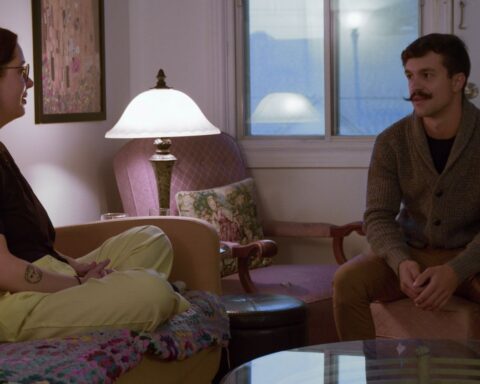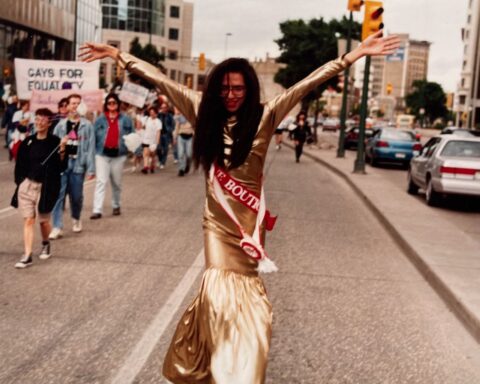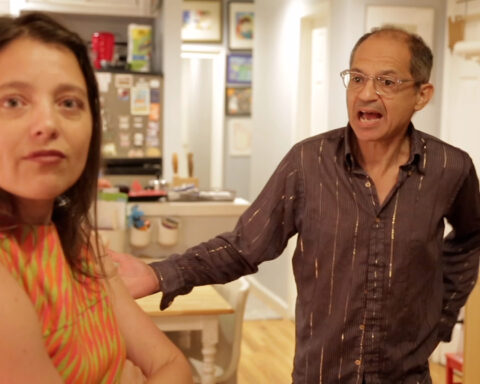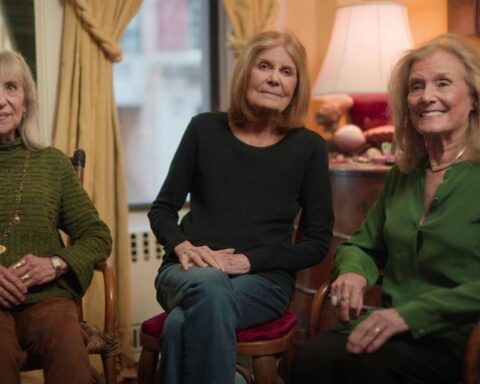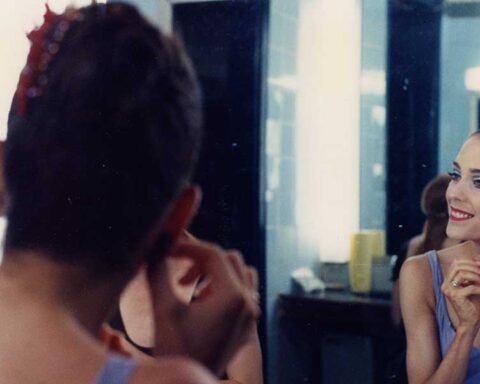IN HIS NEW DOCUMENTARY FILM, Fierce Light: When Spirit Meets Action, Velcrow Ripper sets out to document non-violent protests around the world. The Toronto-based filmmaker is searching for examples of peaceful activism—what Gandhi called “soul force.” Compared to Ripper’s Genie-winning ScaredSacred, which sought hope in the world’s most dangerous places, including Cambodia, Afghanistan, Israel, where he was shot at, and New York City, where he happened to be on September 11, _Fierce Light_’s mission would seem a relatively less dangerous pursuit. But in its shocking first scene, the film exposes the risk involved not only for the Martin Luther Kings of today but for the media activists documenting their causes.
IT’S 2006 IN OAXACA, Mexico, and Brad Will, Ripper’s friend and fellow journalist, is caught in a street fight between unarmed civilians and paramilitary gunmen, his urgent, darting video camera bombarded with sounds of gunshots and shouting as people rush for cover. The camera zig-zags across the street and then swoops under a big truck. “Put away the damn camera!” somebody yells. Suddenly, the camera is up again bolting to the next building. Then another gun-shot and an abrupt, instantaneous yelp. The camera spins into a dirt-road close-up, then lunges across it several feet to a building. Settles on a step. Stillness. Staring. A distant pah-pah-pah of another gun.
Brad Will did not let go of his camera when he was shot dead.
Seconds later, we see Ripper in those streets, wielding his camera in front of the heavily armed paramilitaries–panning inches away from their black-masked faces.
“BRAD’S DEATH SHOOK ME to the core,” says Ripper, who narrates the film.
The tragedy caused Ripper to question whether peaceful activism can be effective in our ruthless socio-political environment. And how far was he willing to go to bear witness? Documenting the crackdown, he writes in his director’s notes, “turned out to be terrifying, one of the most dangerous film shoots of my life.”
But the Oaxaca experience left Ripper even more determined to continue where Brad Will had left off. “Brad’s death informed Velcrow’s quest,” says _Fierce Light_’s producer Cher Hawrysh. “It strengthened his commitment to making films that can be a source of change.”
“We live in a media world,” Ripper says, “a world where wars are not fought on the battleground. Wars are fought in the media. Change can also happen in the media.” He’s sitting in a lush community garden in East Vancouver, a few days before Fierce Light would premiere at VIFF (the Vancouver International Film Festival) and go on to win the National Film Board’s Most Popular Canadian Documentary Award and Special Mention for the VIFF Nonfiction Feature Award. Ripper is affable and open-minded, with a predilection for vibrant clothes—today’s green leather jacket, bright blue shirt, and dapper fedora on his buzz-bald head matching his upbeat nature.
As a self-described media activist, his intent is to make the world a better place with the help of his camera. And while he acknowledges the destructive power of the media, especially in the spinned wake of 9/11, he points out that such recent feature documentaries as Michael Moore’s Fahrenheit 9/11, Al Gore’s An Inconvenient Truth and and What the Bleep Do We Know have galvanized popular movements and had a tremendous impact on audiences. Closer to home, The Corporation, for which he won a Leo Award for sound design, inspired packed screenings that were more like rallies. The film has become Canada’s most successful documentary ever.
“Films like Velcrow’s and mine aim to inspire people to change the way they think and act,” Mark Achbar, who co-directed The Corporation and is one of Fierce Light‘s executive producers, wrote in an email. “We both have evidence we’ve succeeded. We connect with our audiences as often as possible in person and online; we get a very real sense of how our films have affected people. They tell us.” When ScaredSacred screened at the 2004 Toronto International Film Festival, it had such a profound effect on viewers it received a Special Jury Award for “Taking the audience on a very personal journey that has universal resonance … and finding hope.”
Fierce Light, another strong, personal statement by Ripper, shows ways that compassion and activism can merge to create a powerful catalyst for change. With ScaredSacred, Ripper discovered that all over the world, people summon compassion to rise above crisis. Fierce Light takes this idea and goes further: it explores what can happen when this “fierce love” is channeled into improving the planet. Ripper travels to Mexico, New Zealand, Africa, India, Sri Lanka, Vietnam, and North America in search of stories of spiritual activism.
In India, the Dalits (once known as The Untouchables) have learned how to stand their ground and empower themselves. In South Africa, Desmond Tutu recounts the role of peaceful protest in ending apartheid, and Gandhi’s great granddaughter, Ashish Ramgobin, illuminates the legacy of the “Original Sacred Warrior.”
At the film’s centre is Ripper’s involvement in the 2007 protest in Los Angeles to save South Central Farms, the largest metropolitan agricultural community in North America. It’s a veritable urban oasis, tended by some 350 Latino families, who are suddenly confronted with a developer’s bulldozer. Ripper documents several days of civil action that draw a thousand people, including celebrities Daryl Hannah and Danny Glover, famed tree-dweller Julia Butterfly Hill, singer Joan Baez, Ralph Nader, spiritual leaders—and a battalion of cops to crush the peaceful activists’ blockade.
The issue proves a luminous metaphor for the theme of Fierce Light. Ripper taps into what he calls “the change zeitgeist,” a global movement that some are calling the largest in history. It’s a “movement of movements,” Ripper says. “It’s millions of small, grassroots organizations that are popping up all over the world, all with some shared values, and that’s what makes a different planet. I felt it when I was making this film—people are ready to come from a place of compassion as opposed to a place of anger. It gives you more power and strategies.”
Whether focused on saving a contemporary Garden of Eden or improving civil rights, Fierce Light suggests that the world’s legions of independent groups are connected by a shared commitment to “compassionate action” driven by the understanding that we’re all in this together.
“The more you look deep within yourself, the more you understand yourself,” the Sri Lankan humanitarian Krishna (Arjuna Krishnaratne) says in the film, in a passage that describes the heart of Fierce Light. “When you close your eyes and meditate, you realize the world is one. We are one. The more I think about interconnectiveness, the more I generate loving kindness. But my loving kindness isn’t enough. I must do something. I must get involved in constructive activity. That’s what we call compassionate action.”
In the days before it screened, Vancouver International Film Festival’s Canadian Images programmer Terry McEvoy, called Fierce Light this year’s “change-your-life film.”
Ripper, who was once dubbed “the Skinny, Polite, Canadian Buddhist Michael Moore,” was raised a Baha’i, studied Buddhism and briefly considered joining the Sufi movement. These days, however, he has developed an allergy to dogma; he’s spiritual but not at all in a religious way. “Too many limitations,” he says, “and for me, being spiritual is actually about real freedom.” The Gibsons, B.C.- born, 45-year-old artist moved from Vancouver to Toronto’s bicycle-only Wards Island three years ago. Though he and his two roommates are known for hosting house concerts and Twilight Bike- In outdoor film nights, Ripper is a demon for work. “He doesn’t turn off,” says Hawrysh, his producer of three years (the two have formed a company FierceLight Films). “It’s his life.”
“I feel like we’re living in the most exciting time in history,” Ripper exclaims. “The possibilities are so enormous. And it’s a make or break it time, too. We could be going into [the new] dark ages or we have an opportunity for an evolutionary bounce. By going to the Ground Zeros, I’ve met the most incredibly inspiring people in the worst circumstances.” These experiences have helped him see that, “as the planet goes into these hard times, given a perspective shift, we can transform them into opportunities. Wall Street collapses? What can come out of that?”
Ripper’s startling optimism and radiant perspective flows through his creative process. He is a gifted cinematographer, who makes among the most visually stunning issue films that exist (“poetic, moving, impressive,” said Variety). Ripper will often go beyond standard footage, rolling out impressionistic successions of striking images, sometimes gorgeous, sometimes esoteric or horrific. “I don’t just want to hit your analytical brain,” he says. “I want to touch in the way that good art can, on a spiritual plain.”
Starting with his earliest documentary, Iran, The Crisis, made when he was 16 in 1979, and including Company of Fear, Open Season, and Bones of the Forest (which won the best feature length documentary award at both the 1996 Hot Docs festival and the Genies), he has always had an experimental approach. ScaredSacred was the first of his 28 films in which the narrative takes a central role. Until that point he eschewed narration altogether. “There’s a purity to that which I long for because something about narration feels like business. ‘I kinda gotta give you this.’”
His viscerally interpretive style also influences the sound he creates for both fiction and documentary films. Ripper is a much sought-after sound designer, who has worked for Atom Egoyan and Bruce McDonald as well as a number of documentarians. His Leo Award for The Corporation is his second; his first Leo for sound design was for Nettie Wild’s acclaimed 1999 documentary A Place Called Chiapas. “He is a great believer in soundscapes, rather than soundtracks,” enthuses Wild. “He treats every single sound as a musical note.” His sound design seems to boost images. “When Velcrow works on a film, it doubles in size. Your image actually gets bigger on the screen.”
Ripper tends to speak of “serendipity,” small miracles that grace his artistic process. It’s a search for beauty that keeps him open to finding it in unexpected places. “You don’t want to show up with a lot of preconceptions. You want to sow the seed, you want to have the germination, but you need to have a questioning mind. If you’re too predetermined, you’re going to block the universe from jamming with you.”
He didn’t simply luck into his world view, though; he credits his parents, who were “deeply spiritual” and always encouraging, for giving him “the gift” of a wonderful, supportive childhood. “My parents said, ‘never do anything just because you’re going to make some money, do it because you need to.’ They inspired me to have a calling. So my creativity is intertwined with a sense of a calling. I’m not looking around for what’s going to sell, I’m looking around for what I’m compelled to do.”
With a nickname like Velcrow Ripper (his real name is Steven Ripper and his friends call him Crow), it’s not surprising that he is a self-realized, somewhat autonomic, individual. He writes, shoots and edits his films and co-runs his film company. “When I’m in the field shooting, I’m already seeing the scenes edited. It’s like, we’re not complete unless there’s a little bit of everything in us and film is a beautiful metaphor for that as a creative expression.”
But he can be possessive about that expression, and when Achbar suggested he open himself to holding public feedback screenings of _Fierce Light_’s rough cuts, “Ripper was initially not enthused.” Says Achbar: “It had been an ‘ego challenge,’ but he went for it, and by the end, he cheerily admitted that there was no such thing as too many feedback screenings.”
Fierce Light, which cost $1.1 million, is being distributed in Canada through Entertainment One’s Seville Pictures. In addition, Hawrysh plans to work with co-producers at the NFB to develop community outreach programs, such as spiritual activist conferences held in conjunction with screenings in each city. “We want to have a social marketing push,” Ripper told Playback magazine in October. “We have a great track record with ScaredSacred, which we self-released, and an enormous fan base, which we’ll tap into. We want that group of supporters to mobilize the audience in each community when the film is released.”
In Vancouver, at the premiere’s after-party, a fiery, young woman in a red dress talked at length with Ripper and later they free-style danced together. She is Sera Beak, a Harvard-trained scholar of world religion and mysticism, and author of The Red Book: A Deliciously Unorthodox Approach To Igniting Your Divine Spark. She’s the mini-skirt-clad “spiritual cowgirl” in Fierce Light, whose message is: we’re all spiritual; spiritualism is knowing yourself, being authentic, and if that’s sexy, go for it. Happily, this is the focus of one of Ripper’s next films. He and the San Francisco-based Beak are collaborating on a documentary called, Redvolution Dare to Disturb the Universe. “It’s about rebel or outlaw spirituality,” says Ripper. “Next weekend, we’re interviewing Tom Robbins (Even Cowgirls Get the Blues). We’re looking for twisted mystics.”
Ripper’s other project is the follow-up to ScaredSacred and Fierce Light, the third of the trilogy. Evolve Dissolve: Another World is Here is another “quest” film, in which Ripper will search for models of other worlds that exist right now. He says it starts with the Big Bang, and moves through science and spiritual plains to the present, with glimpses of a utopian future. Current example: In Gaviotas, Colombia, a formerly inhospitable salt desert has been transformed by an Italian visionary into a sustainable village, complete with forests and clever inventions to harness energy.
“It’s a place where new models of possible futures are being lived,” says Ripper.




